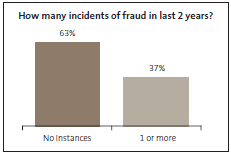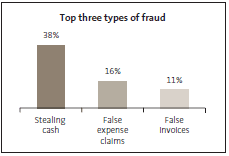Part 3: Incidents of fraud in tertiary education institutions

Despite our generally "clean" image, fraud is a fact of business life in New Zealand: 37% of the respondents were aware of at least one incident of fraud or corruption in their tertiary education institution within the last two years. This was one of the highest rates within the central government sector.
Those who knew of an incident in the last two years were asked for details of the most recent incident.
The value of the most recent fraud noted by respondents in tertiary education institutions was mostly low, with 73% of frauds being for amounts of less than $10,000. Respondents put the monetary loss for 12% of fraud incidents between $10,000 and $100,000, and no-one identified losses of more than $100,000. Fifteen per cent of the respondents who answered this question did not know how much money was lost.
These trends in low dollar amounts were common to all sectors in the survey. It is not always possible to accurately establish how much money has been lost in a fraud because sometimes the records and the investigation are incomplete.
Most of the fraud incidents in tertiary education institutions (88%) were committed by an internal person, typically at an operational or support staff level.

The most frequent types of fraud within tertiary education institutions were:
- theft of cash (38%);
- fraudulent expense claims (16%); and
- falsifying invoices (11%).
Most commonly, fraud occurred because internal controls were not followed or were overridden (27%), and because the perpetrator did not think they would get caught (24%).
Tip-offs (internal and external) led to 42% of the frauds being detected, and internal control systems were tertiary education institutions' second most successful mechanism for detecting fraud (39%). A formal whistle-blowing system detected 3% of fraud.
Respondents said that 3% of the fraud incidents were detected by the external auditor. This low percentage is not surprising, because detecting fraud is neither the purpose nor the focus of an external audit.
Questions 32 to 40 in Appendix 1 set out the survey response data about incidents of fraud.
page top